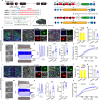Anterior cingulate cortex parvalbumin and somatostatin interneurons shape social behavior in male mice
- PMID: 40320404
- PMCID: PMC12050299
- DOI: 10.1038/s41467-025-59473-z
Anterior cingulate cortex parvalbumin and somatostatin interneurons shape social behavior in male mice
Abstract
The anterior cingulate cortex (ACC) is essential for social behavior, and its dysfunction is implicated in social interaction deficits in autism. Pyramidal neuron activity in the ACC is modulated by parvalbumin (PV) and somatostatin (SST) interneurons, though their specific roles in social interactions remain unclear. Here, we demonstrate that PV and SST interneurons differentially contribute to the regulation of social interactions. In a Shank3-deficient autistic model, the expression of Kcnh7, a risk gene for autism, is reduced in both PV and SST interneurons. Knocking out Kcnh7 in either interneuron subtype leads to social interaction deficits. Furthermore, projections from the lateral posterior thalamic nucleus (mediorostral part, LPMR) to PV interneurons and from the ventral hippocampus (vHPC) to SST interneurons differentially modulate social interactions. These findings provide new insights into the distinct roles of PV and SST interneurons in social processes and their contributions to autism-related pathophysiology.
© 2025. The Author(s).
Conflict of interest statement
Competing interests: The authors declare no competing interests.
Figures










References
-
- Moy, S. S. et al. Sociability and preference for social novelty in five inbred strains: an approach to assess autistic-like behavior in mice. Genes Brain Behav.3, 287–302 (2004). - PubMed
-
- Tian, R. et al. Modeling SHANK3-associated autism spectrum disorder in Beagle dogs via CRISPR/Cas9 gene editing. Mol. Psychiatry28, 3739–3750 (2023). - PubMed
-
- Ariyasiri, K. et al. Pharmacological (ethanol) and mutation (sam2 KO) induced impairment of novelty preference in zebrafish quantified using a new three-chamber social choice task. Prog. Neuro-Psychopharmacol. Biol. Psychiatry88, 53–65 (2019). - PubMed
MeSH terms
Substances
Grants and funding
- 32394032/National Natural Science Foundation of China (National Science Foundation of China)
- 82221001/National Natural Science Foundation of China (National Science Foundation of China)
- 82271577/National Natural Science Foundation of China (National Science Foundation of China)
- 82071536/National Natural Science Foundation of China (National Science Foundation of China)
- 82271578/National Natural Science Foundation of China (National Science Foundation of China)
LinkOut - more resources
Full Text Sources
Molecular Biology Databases

